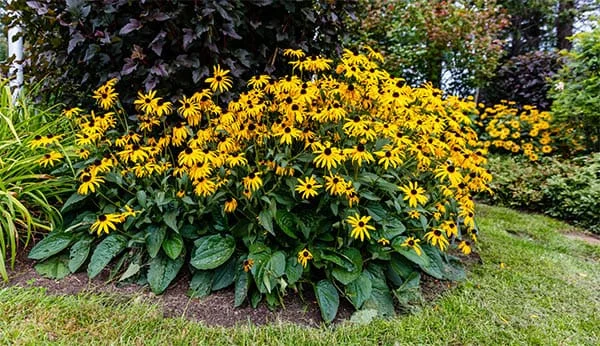Black-eyed susans (also known as rudbeckia or coneflowers) are beautiful wildflowers that can be found across much of the eastern United States, from Florida to Maine.
So, seeing them while you’re on your travels isn’t unusual—however, that doesn’t mean there isn’t a spiritual significance there.

Their bright yellow petals and dark brown centers make them a popular choice for gardens, but they also hold a special place in many spiritual and cultural traditions.
For some people, seeing black-eyed susans in the wild or in their gardens can be a sign of good luck, a symbol of beauty and resilience, or a reminder of the interconnectedness of all living things.
In this article, we’ll explore the spiritual meaning of black-eyed susans, their history and symbolism, and how they can inspire us to connect more deeply with the natural world around us.
Symbolism of Flowers
Flowers have been used for centuries as a way to communicate various meanings and emotions.
Different types of flowers have different symbolic meanings, and black-eyed susans are no exception.
In many cultures, black-eyed susans are seen as a symbol of encouragement, positivity, and good fortune.

They are believed to represent a powerful energy that can bring joy and happiness to those who encounter them.
The symbolic significance of black-eyed susans can vary depending on the cultural context, but they are generally seen as a positive and uplifting symbol.
Characteristics of Black-Eyed Susans
Black-eyed susans are vibrant wildflowers with sunny yellow petals and dark brown, almost black centers.
They are a member of the sunflower family and are native to North America, particularly the eastern and central regions.

The physical characteristics of black-eyed susans play a role in their spiritual significance, as the bright yellow petals can represent joy and positivity, while the dark centers can symbolize focus and inner vision.
These flowers also have a strong and sturdy stem, which may be seen as a symbol of resilience and strength in the face of adversity.
Historical and Cultural Significance of Black-Eyed Susans
Black-eyed Susans have a rich history and cultural significance that dates back centuries.
In Native American culture, the flower is believed to have medicinal properties and was used to treat a range of ailments, such as snake bites, earaches, and swelling.

The Cherokee people also used the black-eyed susan as a symbol of endurance and resilience, as it was known to thrive in difficult conditions.
The black-eyed susan is also believed to bring good luck and prosperity to those who cultivated it.
As a result, the flower has become a popular garden plant in Europe.
The Significance of the Color Yellow
The color yellow holds significant spiritual and symbolic meaning in different contexts.
It is often associated with happiness, joy, and positivity, as well as with the energy of the sun and warmth.
In the case of the black-eyed susan, the bright yellow color of its petals is believed to symbolize the warmth and energy of the sun, as well as the qualities of happiness and joy that it represents.

Additionally, yellow is sometimes associated with the solar plexus chakra, which is linked to personal power, confidence, and self-esteem.
The presence of the color yellow in the black-eyed susan may also be seen as a reminder to connect with these aspects of oneself and cultivate a sense of personal empowerment.
The Beauty of Simplicity
Black-Eyed Susans aren’t fancy. They don’t have the elegance of roses or the exotic allure of orchids. But their beauty lies in their simplicity.
They’re a reminder that we don’t need to be extravagant to be beautiful. We just need to be ourselves.
From their humble beginnings as tiny seeds to their transformation into radiant blooms, Black-Eyed Susans embody simplicity at every stage.
They don’t rush, they don’t fuss. They just grow, at their own pace, in their own time, teaching us a lesson in patience and going with the flow.
In a world that often equates complexity with value, Black-Eyed Susans stand as a testament to the beauty of simplicity.
They don’t strive to be anything other than what they are. And in being themselves, they’re absolutely beautiful.
Their beauty lies not just in their golden petals or their dark centers, but in their simplicity, their authenticity.
It’s in their ability to be beautiful, just by being. And that, indeed, is a beauty that’s truly worth celebrating.
The Lesson of Resilience
I remember the day a storm swept through our town, leaving a trail of destruction in its wake.
Trees were uprooted, roofs were torn off, and the once vibrant garden was left in ruins.
But amidst the chaos and devastation, there was a patch of Black-Eyed Susans standing tall and proud.
They were a little battered, yes, but they were not broken. They had withstood the storm, their roots holding firm, their golden faces turned towards the sky.
This sight was a revelation to me.
Here were these simple, unassuming flowers showing a strength and resilience that was truly inspiring.
They didn’t just survive the storm; they thrived despite it.
They were a testament to the power of resilience, a living embodiment of the saying, "What doesn't kill you makes you stronger."
They taught me that no matter what storms life throws at us, we have the capacity to withstand them.
We can be battered, but not broken. We can face adversity and come out stronger on the other side.
The Extraordinary in the Everyday
Every day, the Black-Eyed Susans would open their petals to the sun, basking in its warmth. It was a simple act, a part of their daily routine.
Yet, there was something extraordinary about it. It was as if they were greeting the day with open arms, embracing the light and warmth with a joyous abandon.
And then, as the sun set, they would close up, as if to rest and rejuvenate. It was a rhythm, a cycle, a dance with the sun that was both ordinary and extraordinary at the same time.
This daily dance of the Black-Eyed Susans was a reminder to find joy in the everyday, to celebrate the ordinary.
- It was a lesson in being present, in appreciating the here and now.
- It was a testament to the fact that life is not just about the big moments, but also about the small, everyday ones.
- It’s about the sunrise and the sunset, the opening and closing of petals, the simple act of being.
- It’s about finding the extraordinary in the ordinary, the magic in the mundane.
A Living Embodiment of Biblical Teachings

In the realm of spirituality, particularly within the context of the Bible, flowers often hold symbolic meanings. The Black-Eyed Susan, with its radiant golden petals and dark center, can be seen as a symbol of the divine contrast between the physical and the spiritual, the human and the divine.
The golden petals of the Black-Eyed Susan, reaching out towards the light, can be interpreted as the human soul’s yearning for divine illumination.
Just as the flower opens itself to the sun, we are encouraged to open our hearts to the light of God’s love and wisdom. This act of opening up, of seeking light, mirrors the biblical call to “seek and you shall find” (Matthew 7:7).
The Dark Center: A Symbol of Divine Mysteries and God’s Unfathomable Nature
The dark center of the Black-Eyed Susan, in contrast, can be seen as a symbol of the mysteries of the divine.
In the Bible, darkness often symbolizes the unknowable aspects of God, the divine mysteries that are beyond human understanding.
The dark center of the flower, then, can remind us of the depth and complexity of God’s nature, of the divine mysteries that we, as humans, can only strive to comprehend.
Embodying Resilience: The Faithful Stand of the Black-Eyed Susan
Furthermore, the resilience of the Black-Eyed Susan, its ability to stand tall and bloom despite the harshest of storms, can be seen as a symbol of faith.
It echoes the biblical message of standing firm in faith despite trials and tribulations.
Just as the Apostle Paul encourages believers in Ephesians 6:13 to put on the full armor of God so that when the day of evil comes, they may be able to stand their ground, the Black-Eyed Susan stands firm, rooted in its faith in the sun.
Conclusion: Spiritual Meaning of the Black-Eyed Susan
In conclusion, black-eyed susans hold a special place in many spiritual and cultural traditions, and their symbolic significance varies depending on the cultural context.
Their bright yellow petals and dark centers, as well as their resilience and strength, make them a symbol of positivity, encouragement, and good fortune.

Furthermore, the color yellow is deeply connected to the qualities of joy, happiness, and personal empowerment, which are all embodied in the black-eyed susan.
By understanding the spiritual meaning of black-eyed susans, we can deepen our connection to the natural world and find inspiration in the beauty and resilience of these vibrant wildflowers.








